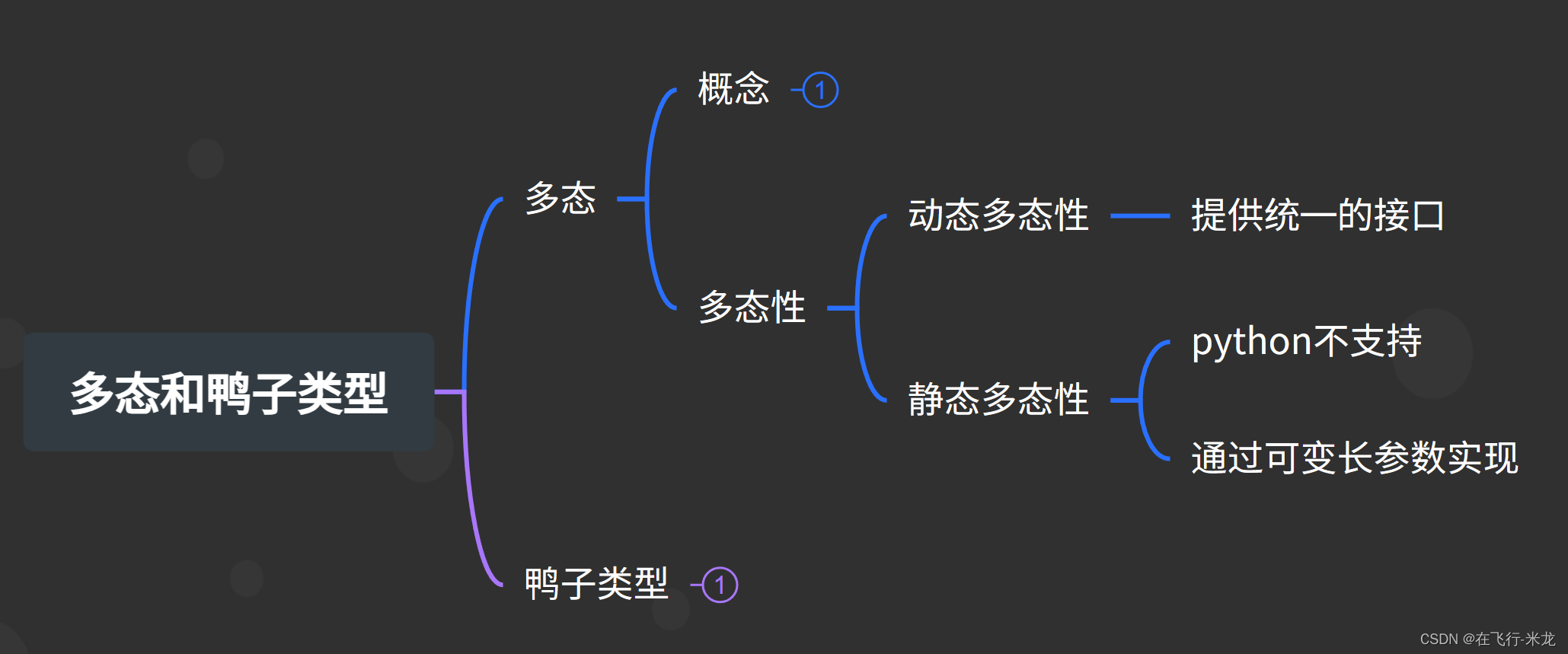Python 面向对象之多态和鸭子类型
发布时间:2024年01月05日
Python 面向对象之多态和鸭子类型
【一】多态
【1】概念
- 多态是面向对象的三大特征之一
- 多态:允许不同的对象对同一操作做出不同的反应
- 多态可以提高代码的灵活性,可扩展性,简化代码逻辑
【2】代码解释
- 在植物大战僵尸中,有寒冰射手,有双发射手还有火焰豌豆射手
- 他们都可以发射豌豆,源于豌豆射手这个类,就算没有发射豌豆的方法也可以继承父类的
class PeaShooter:
def shoot(self):
pass
class IcePeaShooter:
def shoot(self):
print("发射一颗寒冰豌豆")
class FirePeaShooter:
def shoot(self):
print("发射一颗火焰豌豆")
class DoublePeaShooter:
def shoot(self):
print("发射两颗普通豌豆")
# 实例化得到三个对象
ice_shooter = IcePeaShooter()
fire_shooter = FirePeaShooter()
double_shooter = DoublePeaShooter()
# 分别可以调用自己的shoot方法,互不干扰
ice_shooter.shoot() # 发射一颗寒冰豌豆
fire_shooter.shoot() # 发射一颗火焰豌豆
double_shooter.shoot() # 发射两颗普通豌豆
【二】多态性
- 多态的重要性质
【1】运行时多态性(动态多态性)
- 也称为方法(函数)重写
- 在运行时,根据对象的实际类型来确定调用哪个方法
- 主要发生在同一层次的类之前
- 在上面的代码中,可以直接提供统一的接口来使用
# 定义统一的接口
def shoot(obj):
obj.shoot()
# 实例化得到三个对象
ice_shooter = IcePeaShooter()
fire_shooter = FirePeaShooter()
double_shooter = DoublePeaShooter()
# 通过接口输入不同的对象,调用相同的方法触发不同的结果
shoot(ice_shooter) # 发射一颗寒冰豌豆
shoot(fire_shooter) # 发射一颗火焰豌豆
shoot(double_shooter) # 发射两颗普通豌豆
【2】编译时多态性(静态多态性)
- 也称为方法(函数)重载
- 在编译阶段,根据方法的参数类型、个数或顺序来决定调用哪个方法
- 主要发生在同一个类中的同名方法之间
class FirePeaShooter:
def shoot(self):
print("发射了一颗火焰豌豆")
def shoot(self, name):
print(f"发向{name}射了一颗火焰豌豆")
def shoot(self, zombie, num):
print(f"向{zombie}发射了{num}颗火焰豌豆")
# 实例化对象
fire_shooter = FirePeaShooter()
# 根据个数判断调用的方法
# fire_shooter.shoot()
# fire_shooter.shoot("普通僵尸")
fire_shooter.shoot("普通僵尸", "2")
- 在python中并没有静态方法重载,可以通过可变长关键字参数实现
- 在python中并没有静态方法重载,可以通过可变长关键字参数实现
- 在python中并没有静态方法重载,可以通过可变长关键字参数实现
class FirePeaShooter:
def shoot(self, *args):
if len(args) == 2:
a = f"向{args[0]}"
b = f"{args[-1]}颗"
elif len(args) == 1:
a = f"向{args[0]}"
b = ""
else:
a = b = ""
print(f"{a}发射了{b}火焰豌豆")
# 实例化对象
fire_shooter = FirePeaShooter()
# 根据个数判断调用的方法
fire_shooter.shoot()
fire_shooter.shoot("普通僵尸")
fire_shooter.shoot("普通僵尸", "2")
# 发射了颗火焰豌豆
# 向普通僵尸发射了颗火焰豌豆
# 向普通僵尸发射了2颗颗火焰豌豆
【三】鸭子类型
-
鸭子类型是一种编程风格,决定一个对象是否有正确的接口
-
鸭子类型的核心思想:如果他走起来像鸭子,叫起来像鸭子,那么他就可以被视为鸭子
-
可以完全不依赖于继承,只要具备相同的属性和方法,同样可以实现不考虑对象类型而使用对象
-
比起继承,鸭子类型在某种程度上是实现了程序的松耦合度
class IcePeaShooter:
def shoot(self):
print("发射一颗寒冰豌豆")
class FirePeaShooter:
def shoot(self):
print("发射一颗火焰豌豆")
class DoublePeaShooter:
def shoot(self):
print("发射两颗普通豌豆")
# 实例化得到三个对象
ice_shooter = IcePeaShooter()
fire_shooter = FirePeaShooter()
double_shooter = DoublePeaShooter()
# 不依赖于继承,只要有相同的方法名
ice_shooter.shoot() # 发射一颗寒冰豌豆
fire_shooter.shoot() # 发射一颗火焰豌豆
double_shooter.shoot() # 发射两颗普通豌豆
【六】总结

文章来源:https://blog.csdn.net/weixin_48183870/article/details/135419509
本文来自互联网用户投稿,该文观点仅代表作者本人,不代表本站立场。本站仅提供信息存储空间服务,不拥有所有权,不承担相关法律责任。 如若内容造成侵权/违法违规/事实不符,请联系我的编程经验分享网邮箱:chenni525@qq.com进行投诉反馈,一经查实,立即删除!
本文来自互联网用户投稿,该文观点仅代表作者本人,不代表本站立场。本站仅提供信息存储空间服务,不拥有所有权,不承担相关法律责任。 如若内容造成侵权/违法违规/事实不符,请联系我的编程经验分享网邮箱:chenni525@qq.com进行投诉反馈,一经查实,立即删除!
最新文章
- Python教程
- 深入理解 MySQL 中的 HAVING 关键字和聚合函数
- Qt之QChar编码(1)
- MyBatis入门基础篇
- 用Python脚本实现FFmpeg批量转换
- 【Unity】Attribute meta-data#com.google.android.play.billingclient.version 多版本库冲突
- 【MATLAB】EMD_LSTM神经网络时序预测算法
- PCB导线阻抗概念
- 记录每日LeetCode 2828.判别首字母缩略词 Java实现
- Java中的封装性及构造方法
- 爬虫你需要知道的:什么是http请求
- 基于springboot技术的美食烹饪互动平台的设计与实现
- 01-Spring Security框架的认证和授权测试
- 汉化Aseprite
- 蓝牙物联网的安全漏洞分析